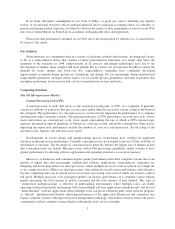AMD 2012 Annual Report Download - page 21
Download and view the complete annual report
Please find page 21 of the 2012 AMD annual report below. You can navigate through the pages in the report by either clicking on the pages listed below, or by using the keyword search tool below to find specific information within the annual report.Other than Intel, our principal competitor in the graphics market is Nvidia. AMD and Nvidia are the two
principal players offering discrete graphics solutions. Other competitors include a number of smaller companies,
which may have greater flexibility to address specific market needs, but less financial resources to do so,
especially as we believe that the growing complexity of visual processors and the associated research and
development costs represent an increasingly higher barrier to entry in this market.
In the game console category, we compete primarily against Nvidia. Other competitors include Intel, ARM
and Imagination.
Research and Development
We focus our research and development activities on improving and enhancing product design. One main
area of focus is on delivering the next generation of products with greater system level integration of the CPU
and GPU, improved system performance and performance-per-watt characteristics. For example, we are focusing
on improving the battery life of our microprocessors and APU products for mobile PCs and the power efficiency
of our microprocessors for servers. We are also focusing on delivering a range of low power integrated platforms
to serve key markets, including commercial clients, mobile computing, and gaming and media computing, as
well as developing a Heterogeneous System Architecture, which is designed for software developers to easily
program APUs by combining scalar processing on the CPU with parallel processing on the GPU, all while
providing high bandwidth access to memory at low power. We believe that these integrated platforms will bring
customers better time-to-market and increased performance and energy efficiency. We also work with industry
leaders on process technology, software and other functional intellectual property and we work with others in the
industry, public foundations, universities and industry consortia to conduct early stage research and development.
Our research and development expenses for 2012, 2011 and 2010 were approximately $1.4 billion,
$1.5 billion and $1.4 billion, respectively. For more information, see Part II, Item 7-“Management’s Discussion
and Analysis of Financial Condition and Results of Operations,” or MD&A.
We conduct product and system research and development activities for our products in the United States
with additional design and development engineering teams located in Canada, India, China, Singapore, Taiwan,
United Kingdom, Israel and Japan.
Manufacturing Arrangements and Assembly and Test Facilities
Third-Party Wafer Foundry Facilities
GLOBALFOUNDRIES, Inc. On March 2, 2009, together with Advanced Technology Investment Company
LLC (ATIC) and West Coast Hitech L.P., (WCH), acting through its general partner, West Coast Hitech G.P.,
Ltd., we formed GLOBALFOUNDRIES, Inc. (GF), a manufacturing joint venture that manufactures
semiconductor products and provides certain foundry services to us.
Wafer Supply Agreement. A Wafer Supply Agreement (WSA) governs the terms by which we purchase
products manufactured by GF. Pursuant to the WSA, we are required to purchase all of our microprocessor and
APU product requirements from GF with limited exceptions.
On April 2, 2011, we entered into a first amendment to the WSA. The primary effect of the amendment was
to change the pricing methodology applicable to wafers delivered in 2011 for our microprocessors, including
APU products. The amendment also modified our existing commitments regarding the production of certain GPU
and chipset products at GF. Pursuant to the amendment, GF committed to provide us with, and we committed to
purchase, a fixed number of 45nm and 32nm wafers per quarter in 2011. We paid GF a fixed price for 45nm
wafers delivered in 2011. Our price for 32nm wafers varied based on the wafer volumes and manufacturing yield
of such wafers and was based on good die. In addition, we also agreed to pay an additional quarterly amount to
13
























